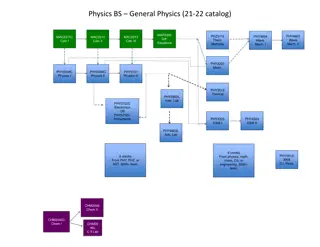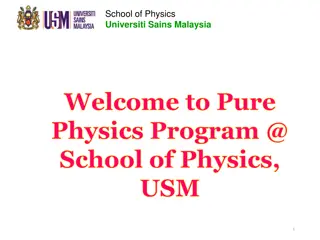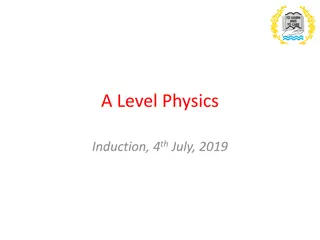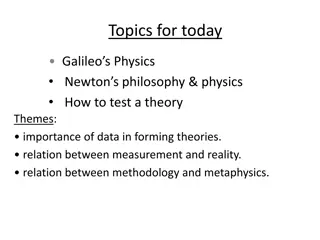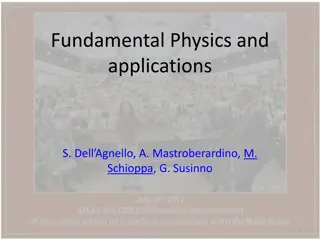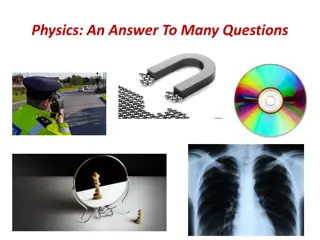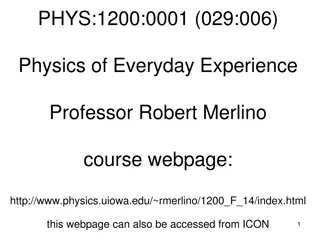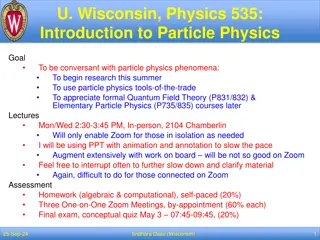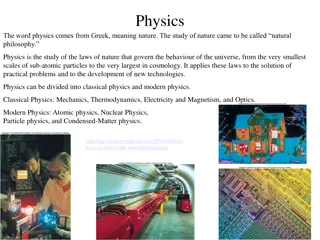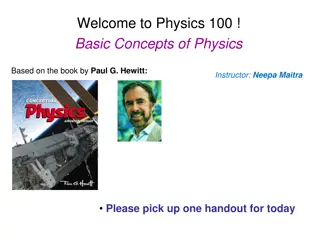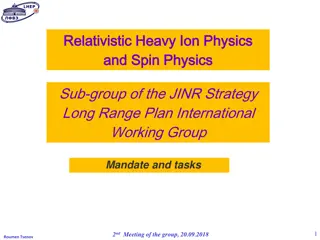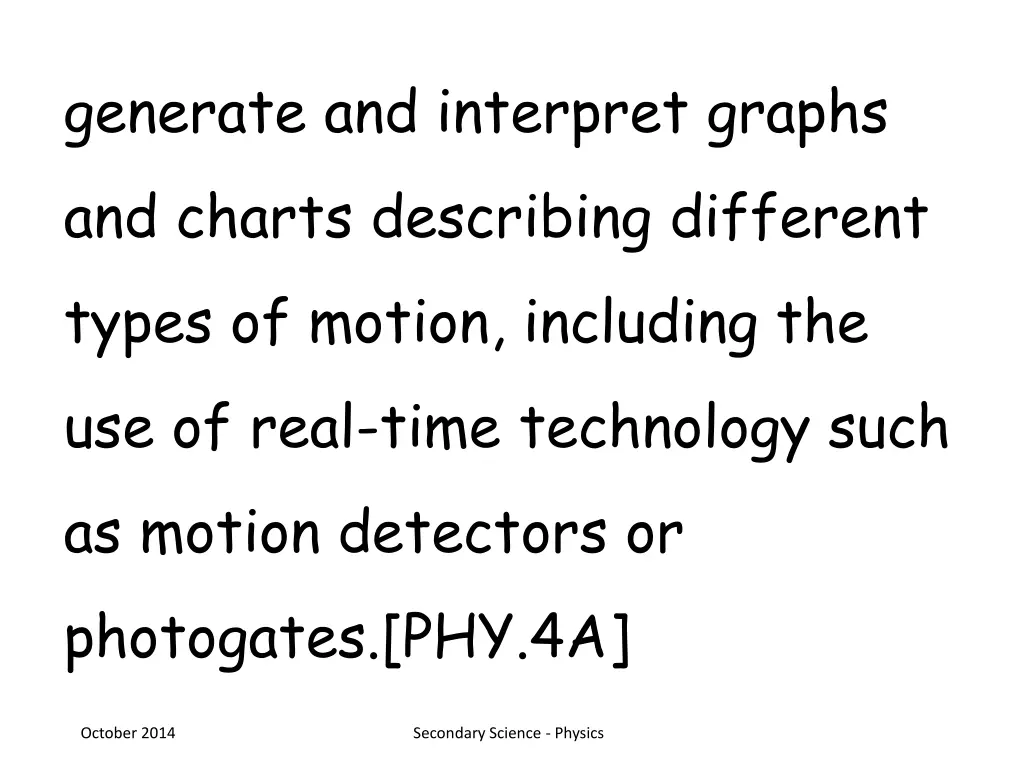
Understanding Physics: Motion, Forces, and Energy Concepts
Explore the fundamental concepts of physics related to motion, forces, and energy. Learn how to analyze motion in one and two dimensions, interpret graphs and charts, calculate forces on objects, and understand the historical development of force concepts. Dive into topics such as distance, displacement, acceleration, and the nature of force pairs between objects.
Download Presentation

Please find below an Image/Link to download the presentation.
The content on the website is provided AS IS for your information and personal use only. It may not be sold, licensed, or shared on other websites without obtaining consent from the author. If you encounter any issues during the download, it is possible that the publisher has removed the file from their server.
You are allowed to download the files provided on this website for personal or commercial use, subject to the condition that they are used lawfully. All files are the property of their respective owners.
The content on the website is provided AS IS for your information and personal use only. It may not be sold, licensed, or shared on other websites without obtaining consent from the author.
E N D
Presentation Transcript
generate and interpret graphs and charts describing different types of motion, including the use of real-time technology such as motion detectors or photogates.[PHY.4A] October 2014 Secondary Science - Physics
describe and analyze motion in one dimension using equations with the concepts of distance, displacement, speed, average velocity, instantaneous velocity, and acceleration.[PHY.4B] October 2014 Secondary Science - Physics
analyze and describe accelerated motion in two dimensions using equations, including projectile and circular examples.[PHY.4C] October 2014 Secondary Science - Physics
calculate the effect of forces on objects, including the law of inertia, the relationship between force and acceleration, and the nature of force pairs between objects.[PHY.4D] October 2014 Secondary Science - Physics
develop and interpret free- body force diagrams.[PHY.4E] October 2014 Secondary Science - Physics
identify and describe motion relative to different frames of reference.[PHY.4F] October 2014 Secondary Science - Physics
research and describe the historical development of the concepts of gravitational, electromagnetic, weak nuclear, and strong nuclear forces.[PHY.5A] October 2014 Secondary Science - Physics
describe and calculate how the magnitude of the gravitational force between two objects depends on their masses and the distance between their centers.[PHY.5B] October 2014 Secondary Science - Physics
describe and calculate how the magnitude of the electrical force between two objects depends on their charges and the distance between them.[PHY.5C] October 2014 Secondary Science - Physics
identify examples of electric and magnetic forces in everyday life.[PHY.5D] October 2014 Secondary Science - Physics
characterize materials as conductors or insulators based on their electrical properties.[PHY.5E] October 2014 Secondary Science - Physics
design, construct, and calculate in terms of current through, potential difference across, resistance of, and power used by electric circuit elements connected in both series and parallel combinations.[PHY.5F] October 2014 Secondary Science - Physics
investigate and describe the relationship between electric and magnetic fields in applications such as generators, motors, and transformers.[PHY.5G] October 2014 Secondary Science - Physics
describe evidence for and effects of the strong and weak nuclear forces in nature.[PHY.5H] October 2014 Secondary Science - Physics
investigate and calculate quantities using the work- energy theorem in various situations.[PHY.6A] October 2014 Secondary Science - Physics
investigate examples of kinetic and potential energy and their transformations.[PHY.6B] October 2014 Secondary Science - Physics
calculate the mechanical energy of, power generated within, impulse applied to, and momentum of a physical system.[PHY.6C] October 2014 Secondary Science - Physics
demonstrate and apply the laws of conservation of energy and conservation of momentum in one dimension.[PHY.6D] October 2014 Secondary Science - Physics
describe how the macroscopic properties of a thermodynamic system such as temperature, specific heat, and pressure are related to the molecular level of matter, including kinetic or potential energy of atoms.[PHY.6E] October 2014 Secondary Science - Physics
contrast and give examples of different processes of thermal energy transfer, including conduction, convection, and radiation.[PHY.6F] October 2014 Secondary Science - Physics
analyze and explain everyday examples that illustrate the laws of thermodynamics, including the law of conservation of energy and the law of entropy.[PHY.6G] October 2014 Secondary Science - Physics
examine and describe oscillatory motion and wave propagation in various types of media.[PHY.7A] October 2014 Secondary Science - Physics
investigate and analyze characteristics of waves, including velocity, frequency, amplitude, and wavelength, and calculate using the relationship between wavespeed, frequency, and wavelength.[PHY.7B] October 2014 Secondary Science - Physics
compare characteristics and behaviors of transverse waves, including electromagnetic waves and the electromagnetic spectrum, and characteristics and behaviors of longitudinal waves, including sound waves.[PHY.7C] October 2014 Secondary Science - Physics
investigate behaviors of waves, including reflection, refraction, diffraction, interference, resonance, and the Doppler effect.[PHY.7D] October 2014 Secondary Science - Physics
describe and predict image formation as a consequence of reflection from a plane mirror and refraction through a thin convex lens.[PHY.7E] October 2014 Secondary Science - Physics
describe the role of wave characteristics and behaviors in medical and industrial applications.[PHY.7F] October 2014 Secondary Science - Physics
describe the photoelectric effect and the dual nature of light.[PHY.8A] October 2014 Secondary Science - Physics
compare and explain the emission spectra produced by various atoms.[PHY.8B] October 2014 Secondary Science - Physics
describe the significance of mass-energy equivalence and apply it in explanations of phenomena such as nuclear stability, fission, and fusion.[PHY.8C] October 2014 Secondary Science - Physics
give examples of applications of atomic and nuclear phenomena such as radiation therapy, diagnostic imaging, and nuclear power and examples of applications of quantum phenomena such as digital cameras.[PHY.8D] October 2014 Secondary Science - Physics


